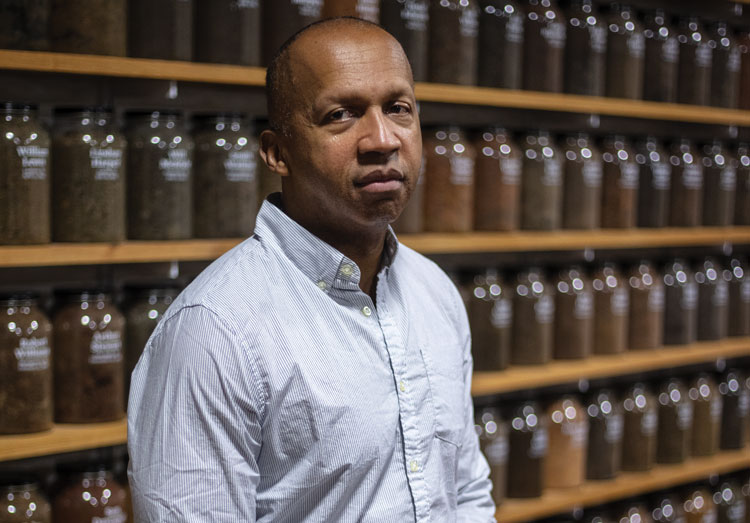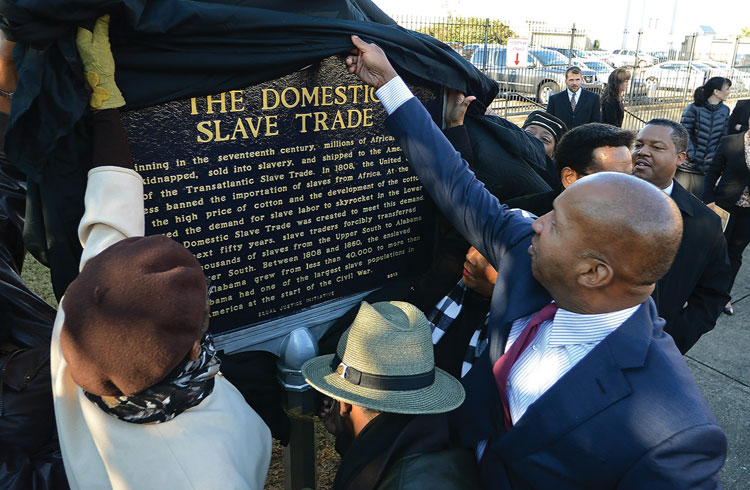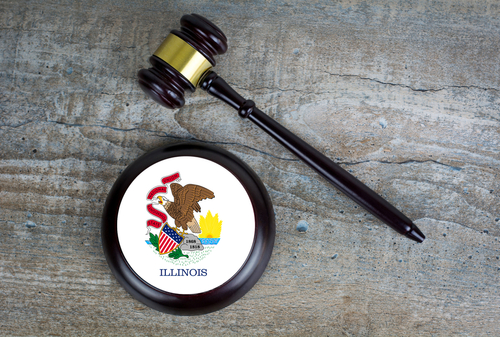Justice, mercy and redemption: Bryan Stevenson's death row advocacy
‘A Full-time life’

The jars behind Stevenson contain soil the Equal Justice Institute’s Community Remembrance Project gathered from lynching sites across the country. Each jar names one victim of lynching and the date in a a memorial wall a the Legacy Museum: From Enslavement to Mass Incarceration. Photo by Lee Bey.
Staffers say that Stevenson has a hand in everything at the EJI—even the music callers hear on hold. Rather than be subjected to Muzak, they are likely to hear Aretha Franklin belting out Otis Redding’s “Respect” or Nat “King” Cole singing “Get Your Kicks on Route 66.” Stevenson selects all the office music and attends to other details that most managers would delegate. On any given day he may edit a brief, teach moot court and choose the layout of the photos on the walls, says Sanneh. “Nothing in the office is too small for him to care about.”
His day starts at an hour most people consider the middle of the night. The alarm goes off at 4 a.m., and he’s in the office by 4:30, except when he fits in a workout at the gym. He says his most productive hours are before 6 a.m. and after 8 p.m. Some weeks he stays in the office until 11 every night and works through the weekend, but he doesn’t find that remarkable.
“For me it’s a full-time life,” he says, noting that the seven-days-a-week marathon is less complicated for him because he is unmarried and does not have children. He finds his joy in the people he works with and represents.
“Bryan has his own metrics for success,” says Sanneh. “He celebrates things that will never be on our website. When a new attorney gets his first client to open up, we celebrate as much as we do when we win a U.S. Supreme Court case.”
When he learned he’d won Miller v. Alabama (2012), in which the court held that mandatory life sentences without the possibility of parole are unconstitutional for juvenile offenders, the halls of the EJI rocked with cheers. A staff meeting followed, but it wasn’t a celebration. “It was about how we haven’t done anything yet, and that what the decision means is up to us,” Sanneh says.
Action is one of Stevenson’s major themes. “If I’ve learned anything it’s that you can’t make a difference, you can’t change the world, you can’t create more equality and opportunity and justice if you’re unwilling to do things that are inconvenient or uncomfortable,” he says. “I have come to understand that you change the world with not just the ideas in your mind but those ideas that are fueled by a conviction in your heart. That has been reinforced by the work that I do.”
A SEGREGATED PAST

Stevenson helps unveil the first Equal Justice Initiative historical marker in downtown Montgomery, Alabama. Photograph by Bernard Troncale.
The great-grandchild of slaves, Stevenson was born and raised in a poor rural community on the eastern shore of southern Delaware that still had what he calls “Jim Crow segregation.” When he started school the education system was still segregated, so he went to an all-black school and transferred to a public school when they were desegregated.
“What I remember most is being told that lawyers came into our community and made them open up the public schools. That intervention is something I never forgot. It made me appreciate the rule of law and how the law can be a tool that helps the disempowered and disfavored,” he says.
Stevenson, who had never met a lawyer before he went to law school, says he entered the profession “by default.” In his senior year as a philosophy major at Eastern University in Pennsylvania, he realized that “no one was going to pay me to philosophize” and started looking into graduate school. “I was a little mortified to discover that if you wanted to do graduate work in history or English or political science, you had to know something about [those subjects]. It seemed that you didn’t have to know anything in particular to go to law school, so I signed up for the LSAT,” he says.
In 1985, Stevenson received both his MA degree in public policy from Harvard University’s John F. Kennedy School of Government and his JD from Harvard Law School. A week before he started law school in 1981, Stevenson was walking down the street in Boston when a truck approached. As it slowed down, the driver yelled, “Hey, where’s Roxbury?”
Stevenson wasn’t familiar with the city yet, so he didn’t know that Roxbury is a predominantly black section of Boston with a high crime rate. The driver taunted him again: “Hey, where’s Roxbury?” Stevenson took a step closer to ask what he meant, and the trucker shouted, “Go back to Roxbury, n——-!”
Darlene Ricker is a legal affairs writer based in Lexington, Kentucky. She is a former staff writer and editor for the Los Angeles Times and the Boston Globe. This article was published in the August 2018 ABA Journal magazine with the title "Justice, Mercy & Redemption: Bryan Stevenson, founder of the Equal Justice Initiative, has learned you can’t change the world without some discomfort or inconvenience."



